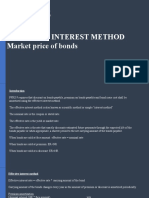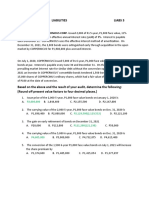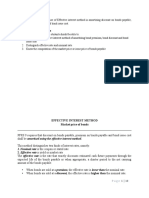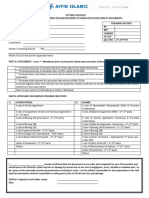Intermediate Accounting II (ACCT 342/542) Winter, 2014 Exam 2 Solutions
Intermediate Accounting II (ACCT 342/542) Winter, 2014 Exam 2 Solutions
Uploaded by
Tzuyu TchaikovskyCopyright:
Available Formats
Intermediate Accounting II (ACCT 342/542) Winter, 2014 Exam 2 Solutions
Intermediate Accounting II (ACCT 342/542) Winter, 2014 Exam 2 Solutions
Uploaded by
Tzuyu TchaikovskyOriginal Description:
Original Title
Copyright
Available Formats
Share this document
Did you find this document useful?
Is this content inappropriate?
Copyright:
Available Formats
Intermediate Accounting II (ACCT 342/542) Winter, 2014 Exam 2 Solutions
Intermediate Accounting II (ACCT 342/542) Winter, 2014 Exam 2 Solutions
Uploaded by
Tzuyu TchaikovskyCopyright:
Available Formats
Intermediate Accounting II (ACCT 342/542)
Winter, 2014
Exam 2 Solutions
Question 1
(1) The proceeds from issuing $5,000,000 of bonds on January 1, 2014, with annual cash interest
payments (first payment due December 31, 2014) and due in 10 years (December 31, 2023). The
bonds have a yield rate 6% and a coupon rate of 8%.
PV ? = 5,747,896
FV 5,000,000 (maturity value)
N 40 = 10*4
I 1.5 = 6/4
pmt 100,000 = 5,000,000*.08*3/12
type end
PV ? = 5,736,009
FV 5,000,000 (maturity value)
N 10
I 6
pmt 400,000 = 5,000,000*.08
type end
(2) The proceeds from issuing $900,000 of serial bonds on January 1, 2014 with annual cash
interest payments (first payment due on December 31, 2014). The bonds have a yield rate 9% and a
coupon rate of 7%. $300,000 of the bonds mature on December 31, 2017, four years from the date
of issue. Another $300,000 of the bonds mature on December 31, 2018, five years from the date of
issue. The final $300,000 of the bonds mature on December 31, 2019, six years from the date of
issue.
PV ? = 280,562 PV ? = 276,662 PV ? = 273,084 280,562
FV 300,000 FV 300,000 FV 300,000 + 276,662
N 4 N 5 N 6 + 273,084
I 9 I 9 I 9 830,308
pmt 21,000 pmt 21,000 pmt 21,000
type end type end type end
(3) The maturity value of a six year bond issue. The bonds call for semi-annual interest payments of
$400,000. When the bonds were issued on January 1, 2014, the yield rate was 10%. The coupon
rate is 8%.
cash interest payment = maturity value * coupon rate
400,000 = maturity value * .08 * 6/12
400,000 = maturity value *.04
400,000 / .04 = maturity value = 10,000,000
Question 2 On January 1, 2014, Alex, Inc., issued 7% coupon bonds with a total maturity value of
$600,000 for $651,954. Interest is payable annually on December 31, and the bonds are issued to yield
5%. These are five year bonds, with a maturity date of December 31, 2018.
1. Prepare a bond amortization table.
Proceeds 651,954
Maturity 600,000
Total # pmts 5
Yield rate 0.05
Coupon rate 0.07
Payment 42,000
Date Tot Pmt Interest Amort Balance
01/01/14 651,954
12/31/14 42,000 32,598 9,402 642,552
12/31/15 42,000 32,128 9,872 632,680
12/31/16 42,000 31,634 10,366 622,314
12/31/17 42,000 31,116 10,884 611,430
12/31/18 42,000 30,570 11,430 600,000
2. Prepare journal entries for 2014 (year 1) and 2015 (year 2).
1/1/14 Cash 651,954
Bonds payable 651,954
12/31/14 Interest expense 32,598
Bonds payable 9,402
Cash 42,000
12/31/15 Interest expense 32,128
Bonds payable 9,872
Cash 42,000
Total Current Long-term Operating Non-op Operating Investing Financing
Liability Liability Liability Income Income Activities Activities Activities
2014 642,552 40,000 602,552 0 –32,598 –42,000 0 651,954
2015 632,680 40,000 592,680 0 –32,128 –42,000 0
2016 622,314 40,000 582,314 0 –31,634 –42,000 0
2017 611,430 611,430 0 0 –31,116 –42,000 0
2018 0 0 0 0 –30,570 –42,000 0 –600,000
Computations:
2014 TL 642,552 = 12/31/14 loan balance
2014 CL 40,000 = PV of 2015 cash interest payment of 42,000
2014 LtL 602,552 = TL ! CL
2014 Op Inc = 0, because interest expense goes in non op income
2014 NonOp Inc = Interest expense
2014 OA = cash interest payment –40,000 (negative because it is a payment out)
2014 FI = amount borrowed +651,954 (positive because it is a receipt of cash)
Question 3 Bonds issued with assistance of investment banker The Cesar Company issues bonds on
January 1, 2014, priced to yield 9%. The bonds have a maturity value of $5,000,000, and call for annual
interest payments of 10% on December 31 of each year, starting on December 31, 2014. These are five
year bonds, maturing on December 31, 2018. After selling the bonds to the investing public, the
investment banker withholds 17% of the gross proceeds as its fee (forwarding 83% of the proceeds to
Cesar).
1. Compute the net proceeds to Cesar (after deducting investment banker fee) from the bond issue.
2 Prepare Cesar’s bond amortization table that will assist in the accounting for the bond issue. Be
sure to designate which interest rate is used for which purpose. Round all amounts to dollars.
Bond proceeds (PV) 5,194,483 883,062 4,311,421 <--Corp proceeds
Maturity value (FV) 5,000,000 IB fee 5,000,000
Years 5 5
Periods / year 1 1
Total periods (N) 5 5
Yield rate (I) 9.000000% 14.012655% <--new rate
Coupon rate 10.000000% 10.000000%
Payment (FV*coup rate) 500,000 500000
Bond Pay
Date Cash pmt Interest Amort. Balance
01/01/14 4,311,421
12/31/14 500,000 604,145 104,145 4,415,566
12/31/15 500,000 618,738 118,738 4,534,304
12/31/16 500,000 635,376 135,376 4,669,680
12/31/17 500,000 654,346 154,346 4,824,026
12/31/18 500,000 675,974 175,974 5,000,000
Question 4 Bond year … fiscal year. On October 1, 2014, Devon issued five year bonds with a maturity
value of $6,000,000 for $5,753,988. The bonds pay 6% interest each October 1 (starting October 1,
2015), and were sold to yield 7%. Devon’s fiscal year ends on December 31.
1. Prepare a bond amortization table.
Date Cash Interest Exp Amortization Balance of BP
10/1/2014 5,753,988
10/1/2015 360,000 402,779 42,779 5,796,767
10/1/2016 360,000 405,774 45,774 5,842,541
10/1/2017 360,000 408,978 48,978 5,891,519
10/1/2018 360,000 412,406 52,406 5,943,925
10/1/2019 360,000 416,075 56,075 6,000,000
2. Prepare journal entries for the following dates:
10/1/14 Cash 5,753,988
Bonds payable 5,753,988
12/31/14 Interest expense 100,695
Bonds payable 10,695
Interest payable 90,000
10/1/15 Interest payable 90,000
Interest expense 302,084
Bonds payable 32,084
Cash 360,000
12/31/15 Interest expense 101,444
Bonds payable 11,444
Interest payable 90,000
10/1/16 Interest payable 90,000
Interest expense 304,330
Bonds payable 34,330
Cash 360,000
3. How will the bonds will be reported on the financial statements for the years ended
December 31, 2014
December 31, 2015
December 31, 2016
December 31, 2017
Total Current Total Current Long-term
Liability Liability Liability Liability Liability
Oct 1 Oct 1 Dec 31 Dec 31 Dec 31
2014 5,753,988 336,449 5,854,683 342,337 5,512,346
2015 5,796,767 336,449 5,898,210 342,337 5,555,873
2016 5,842,541 336,449 5,944,785 342,337 5,602,445
2017 5,891,519 336,419 5,994,621 342,337 5,652,284
Operating Non-op Operating Investing Financing
Income Income Activities Activities Activities
2014 0 100,695 0 0 +5,753,988
2015 0 403,528 –360,000 0 0
2016 0 406,579 –360,000 0 0
2017 0 409,835 –360,000 0 0
2014 2015 2016 2017
402,779 3/12 100,695 9/12 302,084
405,774 3/12 101,444 9/12 304,330
408,978 3/12 102,245 9/12 306,733
412,406 3/12 103,102
105,695 403,528 406,579 409,835
Question 5 Assignment of Accounts Receivable. Specific customer accounts receivable totaling
$3,000,000 were assigned to Ethan Finance Company by Scott Retail, Inc. as collateral for a $2,000,000
loan. Customers continue to pay Scott Retail, and Scott Retail pays the finance company for charges,
interest and loan paydown. At the time of the loan, the Ethan Finance disburses to Scott Retail loan
amount less a four percent finance charge on the amount of the loan.
The journal entry or entries at the time of the loan for assigning the accounts receivable and the transfer of
cash.
Beg 1st mo Cash 1,920,000
Finance expense 80,000
Notes payable 2,000,000
During the first month, Scott Retail collected $500,000 on the assigned accounts. This amount is remitted
to the finance company for payment of one month’s interest (1.5% interest on the unpaid loan balance
from the start of the month) and principal paydown.
The journal entry or entries at the end of the first month recording Scott Retail’s cash collection and the
transfer of cash to Ethan Finance.
End 1st mo Cash 500,000
Accounts receivable 500,000
Notes payable 470,000
Interest expense 30,000
Cash 500,000
During the second month, Scott Retail collected $900,000 on the assigned accounts. This amount (could
be less if not all if needed to repay the remaining loan balance) is remitted to the finance company for
payment of one month’s interest (1.5% interest on the unpaid loan balance from the start of the month)
and principal paydown.
The journal entry or entries at the end of the second month recording Scott Retail’s cash collection and the
transfer of cash (if needed) to Ethan Finance.
End 2nd mo Cash 900,000
Accounts receivable 900,000
Notes payable 877,050
Interest expense 22,950
Cash 900,000
During the third month, Scott Retail collected $800,000 on the assigned accounts. This amount (could be
less, could be all if needed to repay the remaining loan balance) is remitted to the finance company for
payment of one month’s interest (1.5% interest on the unpaid loan balance from the start of the month)
and principal paydown.
The journal entry or entries at the end of the third month recording Scott Retail’s cash collection and the
transfer of cash (if needed) to Ethan Finance.
End 3rd mo Cash 800,000
Accounts receivable 800,000
Notes payable 652,950
Interest expense 9,794
Cash 662,744
During the fourth month, Scott Retail collected $800,000 on the assigned accounts. This amount (could
be less, could be all if needed to repay the remaining loan balance) is remitted to the finance company for
payment of one month’s interest (1.5% interest on the unpaid loan balance from the start of the month)
and principal paydown.
The journal entry or entries at the end of the fourth month recording Scott Retail’s cash collection and the
transfer of cash (if needed) to Ethan Finance.
End 4th mo Cash 800,000
Accounts receivable 800,000
Question 6 Factoring Accounts Receivable. On June 1, 2014, the Reggie Company factors (sells)
$300,000 of accounts receivable to a finance company on a with recourse basis. Reggie’s customers are
instructed to make payments to the finance company. The finance pays 82% of the accounts receivable to
Reggie. However, Reggie agrees to recompense the finance company in the future for any uncollectible
accounts, up to a maximum of $9,000. It is likely that Reggie will have to pay all $9,000.
1. Compute the amount of gain or loss that Reggie must recognize on the sale of the receivables.
Proceeds 246,000
Future payout –9,000
Net proceeds 237,000
less Book Value –300,000
loss –63,000
2. Write the journal entry that records for the sale of the receivables.
Cash 246,000
Loss 63,000
Due to factor 9,000
Accounts receivable 300,000
3. Write the journal entry for two months later when Reggie makes good on its recourse promise and
pays $9,000 to the finance company.
Due to factor 9,000
Cash 9,000
You might also like
- Case Spreadsheet NewDocument6 pagesCase Spreadsheet NewUsman Ch0% (2)
- NikitaJain FA DCF Modelling Test 1Document25 pagesNikitaJain FA DCF Modelling Test 1NIKHIL AGARWALNo ratings yet
- Forecasting ProblemsDocument7 pagesForecasting ProblemsJoel Pangisban0% (3)
- Fa 2 1Document8 pagesFa 2 1Quỳnh Anh NguyễnNo ratings yet
- Auditing ProblemsDocument67 pagesAuditing ProblemsAngelica Ann Salen100% (1)
- Noncurrent Liabilities - PROBLEMS: B. A DiscountDocument12 pagesNoncurrent Liabilities - PROBLEMS: B. A DiscountIra Grace De Castro67% (3)
- Supply Chain Finance at Procter & Gamble - 6713-XLS-ENGDocument37 pagesSupply Chain Finance at Procter & Gamble - 6713-XLS-ENGKunal Mehta100% (2)
- Proposal For ThesisDocument8 pagesProposal For ThesisDestiny Tuition Centre50% (2)
- KKR Transaction Announcement Presentation July 2008Document41 pagesKKR Transaction Announcement Presentation July 2008AsiaBuyoutsNo ratings yet
- Effective Interest MethodDocument31 pagesEffective Interest MethodMikaela LacabaNo ratings yet
- P13.14 Bài LàmDocument12 pagesP13.14 Bài Làmqgminh7114No ratings yet
- Intermidiate 1 Quiz ExamDocument2 pagesIntermidiate 1 Quiz ExamLT pudgeNo ratings yet
- CH 14: Long Term Liabilities: The Timelines of The Bonds Will Be As FollowsDocument9 pagesCH 14: Long Term Liabilities: The Timelines of The Bonds Will Be As Followschesca marie penarandaNo ratings yet
- AE 16 Effective Interest MethodDocument14 pagesAE 16 Effective Interest MethodMiles CastilloNo ratings yet
- AC21 - Financial Liabilities - PracticalDocument4 pagesAC21 - Financial Liabilities - PracticalLouise GabrielNo ratings yet
- Lã Minh Ngọc - 18071385 - INS3007Document15 pagesLã Minh Ngọc - 18071385 - INS3007Ming NgọhNo ratings yet
- Ia PPT 6Document20 pagesIa PPT 6lorriejaneNo ratings yet
- Lecture Workings - 29.03.2023Document3 pagesLecture Workings - 29.03.2023kasun SenadheeraNo ratings yet
- Bond Payable Problems - CompressDocument23 pagesBond Payable Problems - CompressJoan Ashley ViernesNo ratings yet
- IPPTChap010 1Document38 pagesIPPTChap010 1JackNo ratings yet
- Financial Analyst G&M - Real Estate Test & Case StudyDocument19 pagesFinancial Analyst G&M - Real Estate Test & Case StudyDhruv ShahNo ratings yet
- MB2001 FA 2025 Week5B Liabilities Practice ExercisesDocument31 pagesMB2001 FA 2025 Week5B Liabilities Practice ExerciseschloeileenspearsNo ratings yet
- Chapter 3 Time Value of MoneyDocument21 pagesChapter 3 Time Value of Moneyndc6105058No ratings yet
- Fra 3Document7 pagesFra 3Subhajyoti MukhopadhyayNo ratings yet
- 2020 Black Dwarf Company: Problem 7 Bonds Payable - Straight Line Method Journal Entries Date Account Title & ExplanationDocument7 pages2020 Black Dwarf Company: Problem 7 Bonds Payable - Straight Line Method Journal Entries Date Account Title & ExplanationLovely Anne Dela CruzNo ratings yet
- MFCB Full Set 2Document9 pagesMFCB Full Set 2Tian Xiang100% (1)
- Me AnswersDocument9 pagesMe Answersgabprems11No ratings yet
- Assignment 1Document7 pagesAssignment 1mohsin aliNo ratings yet
- Quiz Box 2 - QuestionnairesDocument13 pagesQuiz Box 2 - QuestionnairesCamila Mae AlduezaNo ratings yet
- Financial Accounting 2022Document5 pagesFinancial Accounting 2022Siddhant GNo ratings yet
- 7 Loan ReceivableDocument10 pages7 Loan ReceivableAYEZZA SAMSONNo ratings yet
- Chapter 20 - Effective Interest Method (Amortized Cost, FVOCI, FVPL)Document66 pagesChapter 20 - Effective Interest Method (Amortized Cost, FVOCI, FVPL)Never Letting GoNo ratings yet
- Gulf Shores Surgery Centers, An Investor-Owned Chain of Ambulatory Surgery Centers With Six Locations in Florida's PanhandleDocument3 pagesGulf Shores Surgery Centers, An Investor-Owned Chain of Ambulatory Surgery Centers With Six Locations in Florida's PanhandleAaliaNo ratings yet
- MVJUSTINIANI - BAFACR16 - INTERIM ASSESSMENT 1 - 3T - AY2022 23 With Answer KeysDocument4 pagesMVJUSTINIANI - BAFACR16 - INTERIM ASSESSMENT 1 - 3T - AY2022 23 With Answer KeysDe Gala ShailynNo ratings yet
- Lobrigas Unit3 Topic1 AssessmentDocument9 pagesLobrigas Unit3 Topic1 AssessmentClaudine LobrigasNo ratings yet
- CC 0742 - 2031 AnnuityDocument1 pageCC 0742 - 2031 AnnuityterrygohNo ratings yet
- Amortization Schedule: PMT I PV I 0.06 PV 2500 N 6 PMT 2500Document4 pagesAmortization Schedule: PMT I PV I 0.06 PV 2500 N 6 PMT 2500Ensbert HarnoisNo ratings yet
- Quantitative ProblemsDocument8 pagesQuantitative ProblemsrahimNo ratings yet
- Chapter 14 - Homework AnswerDocument10 pagesChapter 14 - Homework AnswerSaja AlbarjesNo ratings yet
- Cpa Review School of The Philippines ManilaDocument2 pagesCpa Review School of The Philippines ManilaSailah DimakutaNo ratings yet
- FIN300 Homework 1Document7 pagesFIN300 Homework 1JohnNo ratings yet
- Assessment Task 3Document5 pagesAssessment Task 3Christian N MagsinoNo ratings yet
- Chapter 7 Loans ReceivableDocument12 pagesChapter 7 Loans ReceivableJohn Fraleigh Dagohoy Carillo100% (2)
- Case Study #1: Bigger Isn't Always Better!Document4 pagesCase Study #1: Bigger Isn't Always Better!Marilou GabayaNo ratings yet
- Prof: John Bo S.Cayetano, Cpa, Mba Assessment For BONDS #01Document2 pagesProf: John Bo S.Cayetano, Cpa, Mba Assessment For BONDS #01John FloresNo ratings yet
- Assignment #1Document5 pagesAssignment #1FreelansirNo ratings yet
- SMChap 006Document22 pagesSMChap 006Anonymous mKjaxpMaLNo ratings yet
- AP-LIABS-3 (With Answers)Document4 pagesAP-LIABS-3 (With Answers)Kendrew SujideNo ratings yet
- Audprob Bonds Problem With SolutionsDocument4 pagesAudprob Bonds Problem With Solutionsreviewrecord.rr2No ratings yet
- Excel AmortizationDocument16 pagesExcel AmortizationLaarnie QuiambaoNo ratings yet
- TVM Problems SolutionsDocument3 pagesTVM Problems SolutionsEmirī PhoonNo ratings yet
- Second Test Paper, 7 Oct 2023Document7 pagesSecond Test Paper, 7 Oct 2023Petrina MatheusNo ratings yet
- Đề KTTCDocument3 pagesĐề KTTChuongcute2003No ratings yet
- Final Project FMGT 80Document12 pagesFinal Project FMGT 80Alma UriasNo ratings yet
- Bonds Payable Bond - Is A Formal Unconditional Promise, Made Under Seal, To Pay A Specified Sum of Money at ADocument8 pagesBonds Payable Bond - Is A Formal Unconditional Promise, Made Under Seal, To Pay A Specified Sum of Money at ACamille BacaresNo ratings yet
- Module - IA Chapter 6Document10 pagesModule - IA Chapter 6Kathleen EbuenNo ratings yet
- Material 4 Investment and Bonds PayableDocument7 pagesMaterial 4 Investment and Bonds PayableosaresfaelNo ratings yet
- Tutorial 13 14 Answer MFRS9Document4 pagesTutorial 13 14 Answer MFRS9NavaneetaNo ratings yet
- IA2Document9 pagesIA2Claire BarbaNo ratings yet
- Understanding the Mathematics of Personal Finance: An Introduction to Financial LiteracyFrom EverandUnderstanding the Mathematics of Personal Finance: An Introduction to Financial LiteracyNo ratings yet
- J.K. Lasser's Small Business Taxes 2021: Your Complete Guide to a Better Bottom LineFrom EverandJ.K. Lasser's Small Business Taxes 2021: Your Complete Guide to a Better Bottom LineNo ratings yet
- A Investment Platform for Future: Self Help a Self Operating BankingFrom EverandA Investment Platform for Future: Self Help a Self Operating BankingNo ratings yet
- RACI K 6 Stefanie Krilich ReportDocument8 pagesRACI K 6 Stefanie Krilich ReportTzuyu TchaikovskyNo ratings yet
- Lecture 35Document3 pagesLecture 35Tzuyu TchaikovskyNo ratings yet
- Dokumen - Tips - Inchausti V Yulo 565736d21f1e3Document3 pagesDokumen - Tips - Inchausti V Yulo 565736d21f1e3Tzuyu TchaikovskyNo ratings yet
- Y Chromosome Fact SheetDocument1 pageY Chromosome Fact SheetTzuyu TchaikovskyNo ratings yet
- Historical Interpretatio and MisconceptionsDocument1 pageHistorical Interpretatio and MisconceptionsTzuyu TchaikovskyNo ratings yet
- The 3 Basic Listening Models and How To Effectively Use ThemDocument6 pagesThe 3 Basic Listening Models and How To Effectively Use ThemTzuyu TchaikovskyNo ratings yet
- 1456 GenderRghtsDev-web PDFDocument160 pages1456 GenderRghtsDev-web PDFTzuyu TchaikovskyNo ratings yet
- 20992NAP Payment Form ReDocument1 page20992NAP Payment Form ReTzuyu TchaikovskyNo ratings yet
- 6Wdwlvwlfvlq$Uwv$Uwhphwulfv": 6Wdwlvwlfv Urxs8Qlyhuvlw/Ri1Hxfkdwho6Zlw) Huodqg KWWSZZZXQLQHFKVWDWLVWLFVDocument2 pages6Wdwlvwlfvlq$Uwv$Uwhphwulfv": 6Wdwlvwlfv Urxs8Qlyhuvlw/Ri1Hxfkdwho6Zlw) Huodqg KWWSZZZXQLQHFKVWDWLVWLFVTzuyu TchaikovskyNo ratings yet
- B5 9 PDFDocument5 pagesB5 9 PDFTzuyu TchaikovskyNo ratings yet
- RFBT1 Oblico Lecture NotesDocument33 pagesRFBT1 Oblico Lecture NotesTzuyu TchaikovskyNo ratings yet
- Statement of Cash Flows Template Using The Direct Method North Carolina Community CollegesDocument30 pagesStatement of Cash Flows Template Using The Direct Method North Carolina Community CollegesSumon MonNo ratings yet
- Your Young Persons Account StatementDocument2 pagesYour Young Persons Account Statementabdi100% (1)
- Chapter3 4Document24 pagesChapter3 4kakolalamamaNo ratings yet
- MCQs On Taxation LawDocument18 pagesMCQs On Taxation LawAli Asghar RindNo ratings yet
- Manishree Gupta - Kotak ProjectDocument106 pagesManishree Gupta - Kotak ProjectmanishreegNo ratings yet
- Bizchannel: Transfer Advice Bizchannel@CimbDocument10 pagesBizchannel: Transfer Advice Bizchannel@CimbShinta TrisiawatiNo ratings yet
- Konsep & Macam Indikator Ekonomi: Prof. Insukindro, PH.DDocument21 pagesKonsep & Macam Indikator Ekonomi: Prof. Insukindro, PH.DAndri IantoNo ratings yet
- Statement 2023 8Document1 pageStatement 2023 89jhdh8qthtNo ratings yet
- Canceled Debts, Foreclosures, Repossessions, and AbandonmentsDocument18 pagesCanceled Debts, Foreclosures, Repossessions, and AbandonmentsrndvdbNo ratings yet
- (Type The Document Title) : (Year)Document4 pages(Type The Document Title) : (Year)Sunil RawatNo ratings yet
- IA Problem1&2Document4 pagesIA Problem1&2Miriam Ubaldo DanielNo ratings yet
- SEB Report: Investors To Move Away From Dollar, EuroDocument44 pagesSEB Report: Investors To Move Away From Dollar, EuroSEB GroupNo ratings yet
- My - Bill - 01 Nov, 2022 - 30 Nov, 2022 - 300286211512Document1 pageMy - Bill - 01 Nov, 2022 - 30 Nov, 2022 - 300286211512aliansari20101996No ratings yet
- CH 16Document7 pagesCH 16cddaniel910411No ratings yet
- Finance GlossaryDocument10 pagesFinance GlossaryhumaidjafriNo ratings yet
- Exercise 1-Use Built-In Functions: Sales May June July August Sum: Average: Min: Max: Today's DateDocument15 pagesExercise 1-Use Built-In Functions: Sales May June July August Sum: Average: Min: Max: Today's DateAmrit Pal SinghNo ratings yet
- FRM Part 1 - Test ID - 0003 - Topic - TVM + Mutual Funds - Questions - 50Document13 pagesFRM Part 1 - Test ID - 0003 - Topic - TVM + Mutual Funds - Questions - 50Kamal BhatiaNo ratings yet
- Topic 4 Accounting For Non Profit Making EntitiesDocument17 pagesTopic 4 Accounting For Non Profit Making Entitiestwahirwajeanpierre50No ratings yet
- Simple Interest: I PRTDocument4 pagesSimple Interest: I PRTRochelle Joyce CosmeNo ratings yet
- The Banking Law Reviewer Hot JuristDocument28 pagesThe Banking Law Reviewer Hot Juristgrego centillas100% (4)
- LI 01 Vetting ChecklistDocument1 pageLI 01 Vetting ChecklistAsyraf WajdiNo ratings yet
- Macro 1Document107 pagesMacro 1ChangeBunnyNo ratings yet
- Households, Firms, Governments and Foreigners: Aggregate Demand Analysis of Closed EconomyDocument142 pagesHouseholds, Firms, Governments and Foreigners: Aggregate Demand Analysis of Closed EconomyAdem SunkemoNo ratings yet
- Grade 10 Provincial Exam Accounting p1 AnswersDocument7 pagesGrade 10 Provincial Exam Accounting p1 AnswershobyanevisionNo ratings yet
- Strategic Cost Management NMIMS AssignmentDocument7 pagesStrategic Cost Management NMIMS AssignmentN. Karthik UdupaNo ratings yet
- Lecture Handout No. 2 Risk and DiversificationDocument9 pagesLecture Handout No. 2 Risk and DiversificationJessa ArellagaNo ratings yet
- 3 - Book of Prime EntryDocument69 pages3 - Book of Prime Entrynurzbiet8587No ratings yet
- Tata CapitalDocument9 pagesTata CapitalAbilu Bin AkbarNo ratings yet




































































































